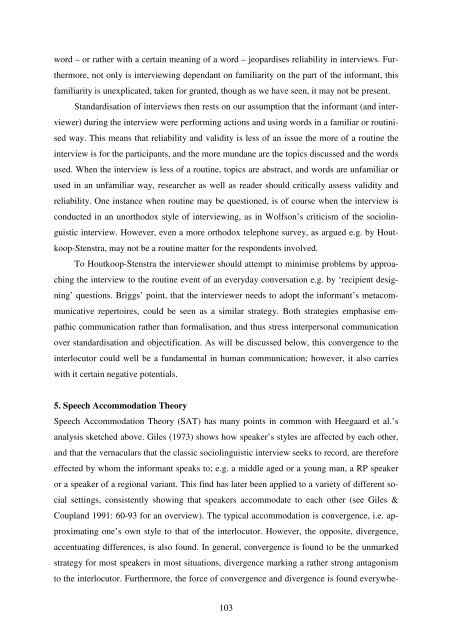Hør dog hvad de siger - Note-to-Self: Trials & Errors
Hør dog hvad de siger - Note-to-Self: Trials & Errors
Hør dog hvad de siger - Note-to-Self: Trials & Errors
You also want an ePaper? Increase the reach of your titles
YUMPU automatically turns print PDFs into web optimized ePapers that Google loves.
word – or rather with a certain meaning of a word – jeopardises reliability in interviews. Fur-<br />
thermore, not only is interviewing <strong>de</strong>pendant on familiarity on the part of the informant, this<br />
familiarity is unexplicated, taken for granted, though as we have seen, it may not be present.<br />
Standardisation of interviews then rests on our assumption that the informant (and inter-<br />
viewer) during the interview were performing actions and using words in a familiar or routini-<br />
sed way. This means that reliability and validity is less of an issue the more of a routine the<br />
interview is for the participants, and the more mundane are the <strong>to</strong>pics discussed and the words<br />
used. When the interview is less of a routine, <strong>to</strong>pics are abstract, and words are unfamiliar or<br />
used in an unfamiliar way, researcher as well as rea<strong>de</strong>r should critically assess validity and<br />
reliability. One instance when routine may be questioned, is of course when the interview is<br />
conducted in an unorthodox style of interviewing, as in Wolfson’s criticism of the sociolin-<br />
guistic interview. However, even a more orthodox telephone survey, as argued e.g. by Hout-<br />
koop-Stenstra, may not be a routine matter for the respon<strong>de</strong>nts involved.<br />
To Houtkoop-Stenstra the interviewer should attempt <strong>to</strong> minimise problems by approa-<br />
ching the interview <strong>to</strong> the routine event of an everyday conversation e.g. by ‘recipient <strong>de</strong>sig-<br />
ning’ questions. Briggs’ point, that the interviewer needs <strong>to</strong> adopt the informant’s metacom-<br />
municative reper<strong>to</strong>ires, could be seen as a similar strategy. Both strategies emphasise em-<br />
pathic communication rather than formalisation, and thus stress interpersonal communication<br />
over standardisation and objectification. As will be discussed below, this convergence <strong>to</strong> the<br />
interlocu<strong>to</strong>r could well be a fundamental in human communication; however, it also carries<br />
with it certain negative potentials.<br />
5. Speech Accommodation Theory<br />
Speech Accommodation Theory (SAT) has many points in common with Heegaard et al.’s<br />
analysis sketched above. Giles (1973) shows how speaker’s styles are affected by each other,<br />
and that the vernaculars that the classic sociolinguistic interview seeks <strong>to</strong> record, are therefore<br />
effected by whom the informant speaks <strong>to</strong>; e.g. a middle aged or a young man, a RP speaker<br />
or a speaker of a regional variant. This find has later been applied <strong>to</strong> a variety of different so-<br />
cial settings, consistently showing that speakers accommodate <strong>to</strong> each other (see Giles &<br />
Coupland 1991: 60-93 for an overview). The typical accommodation is convergence, i.e. ap-<br />
proximating one’s own style <strong>to</strong> that of the interlocu<strong>to</strong>r. However, the opposite, divergence,<br />
accentuating differences, is also found. In general, convergence is found <strong>to</strong> be the unmarked<br />
strategy for most speakers in most situations, divergence marking a rather strong antagonism<br />
<strong>to</strong> the interlocu<strong>to</strong>r. Furthermore, the force of convergence and divergence is found everywhe-<br />
103



